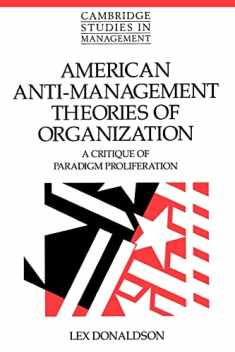
Organizational Structure in American Police Agencies: Context, Complexity, and Control (Suny Series in New Directions in Crime and Justice Studies)
ISBN-13:
9780791455128
ISBN-10:
0791455122
Author:
Edward R. Maguire
Publication date:
2003
Publisher:
State University of New York Press
Format:
Paperback
304 pages
Category:
Law Enforcement
,
Criminal Law
,
Criminology
,
Social Sciences
,
Sociology
,
United States
,
Politics & Government
FREE US shipping
Book details
ISBN-13:
9780791455128
ISBN-10:
0791455122
Author:
Edward R. Maguire
Publication date:
2003
Publisher:
State University of New York Press
Format:
Paperback
304 pages
Category:
Law Enforcement
,
Criminal Law
,
Criminology
,
Social Sciences
,
Sociology
,
United States
,
Politics & Government
Summary
Organizational Structure in American Police Agencies: Context, Complexity, and Control (Suny Series in New Directions in Crime and Justice Studies) (ISBN-13: 9780791455128 and ISBN-10: 0791455122), written by authors
Edward R. Maguire, was published by State University of New York Press in 2003.
With an overall rating of 4.3 stars, it's a notable title among other
Law Enforcement
(Criminal Law, Criminology, Social Sciences, Sociology, United States, Politics & Government) books. You can easily purchase or rent Organizational Structure in American Police Agencies: Context, Complexity, and Control (Suny Series in New Directions in Crime and Justice Studies) (Paperback) from BooksRun,
along with many other new and used
Law Enforcement
books
and textbooks.
And, if you're looking to sell your copy, our current buyback offer is $0.3.
Description
A new theory accounts for the characteristics of individual police departments.
Although most large police organizations perform the same tasks, there is tremendous variation in how individual organizations are structured. To account for this variation, author Edward R. Maguire develops a new theory that attributes the formal structures of large municipal police agencies to the contexts in which they are embedded. This theory finds that the relevant features of an organization’s context are its size, age, technology, and environment. Using a database representing nearly four hundred of the nation’s largest municipal police agencies, Maguire develops empirical measures of police organizations and their contexts and then uses these measures in a series of structural equation models designed to test the theory. Ultimately, police organizations are shown to be like other types of organizations in many ways but are also shown to be unique in a number of respects.
Although most large police organizations perform the same tasks, there is tremendous variation in how individual organizations are structured. To account for this variation, author Edward R. Maguire develops a new theory that attributes the formal structures of large municipal police agencies to the contexts in which they are embedded. This theory finds that the relevant features of an organization’s context are its size, age, technology, and environment. Using a database representing nearly four hundred of the nation’s largest municipal police agencies, Maguire develops empirical measures of police organizations and their contexts and then uses these measures in a series of structural equation models designed to test the theory. Ultimately, police organizations are shown to be like other types of organizations in many ways but are also shown to be unique in a number of respects.


We would LOVE it if you could help us and other readers by reviewing the book
Book review

Congratulations! We have received your book review.
{user}
{createdAt}
by {truncated_author}



